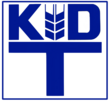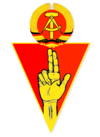National Front of the German Democratic Republic
National Front of the German Democratic Republic Nationale Front der Deutschen Demokratischen Republik | |
|---|---|
 | |
| Chairman | (1950–1981) (1981–1990) |
| Founded | 30 March 1950 |
| Dissolved | 20 February 1990 |
| Headquarters | East Berlin, German Democratic Republic |
| Ideology | Communism Marxism–Leninism |
| Political position | Far-left |
| |
The National Front of the German Democratic Republic (German: Nationale Front der Deutschen Demokratischen Republik) was an alliance of political parties (Blockpartei) and mass organizations in the German Democratic Republic, controlled by the Socialist Unity Party of Germany (SED), which stood in elections to the East German parliament, the Volkskammer ("People's Chamber").
The purpose of the NF was to give the impression that the GDR was a democracy governed by a broad-based coalition. In fact, all parties and mass organizations were subservient to the SED, and had to officially accept the SED's leading role as a condition of their existence. In elections, voters only had the option of approving or rejecting a single "united list" of NF candidates. Two of the block parties were formerly independent and two others were established on the instigation of the SED. The SED members on the list were always the majority because many candidates of the mass organizations were also SED members.[1]
In the last weeks prior to the fall of the Berlin Wall (November 1989), some politicians of non-SED parties started to moderately criticize SED dominance. The Front disbanded in February 1990, a month before the first free elections in the GDR.
Constituent parties[]
 |
|---|
|
| Party | Emblem | Flag | Foundation | Dissolution | Seats in the Volkskammer (1986) |
|---|---|---|---|---|---|
| Socialist Unity Party SED |
 |
 |
21 April 1946 | 16 December 1989 | 127 |
| Christian Democratic Union CDU |
 |
 |
26 June 1945 | 1/2 October 1990 | 52 |
| Liberal Democratic Party LDPD |
 |
 |
5 July 1945[2] | 11 August 1990 | 52 |
| Democratic Farmers' Party DBD |
 |
 |
17 June 1948 | 15 September 1990 | 52 |
| National Democratic Party NDPD |
 |
 |
5 May 1948[3][4] | 27 March 1990 | 52 |
Constituent mass organizations represented in the People's Chamber[]
| Organization | Emblem | Flag | Foundation | Dissolution | Assigned representatives in the Volkskammer (1986) |
|---|---|---|---|---|---|
| Free German Trade Union Federation FDGB |
 |
 |
1946 | 1990 | 61 |
| Free German Youth FDJ |
 |
 |
1946 | exists today | 37 |
| Democratic Women's League of Germany DFD |
 |
1947 | 1990 | 32 | |
| Cultural Association of the DDR KB |
 |
 |
1945 | 1990 | 21 |
| Peasants Mutual Aid Association VdgB |
 |
 |
1945 | 1994 | 14 |
Other organizations associated with the National Front[]
The following organizations, which were part of the NF, did not send elected representatives to the Volkskammer but were active in the performance of its activities.
| Organization | Emblem | Foundation | Dissolution |
|---|---|---|---|
| Society for German–Soviet Friendship |  |
1949 | 1992 |
| People's Solidarity |  |
1945 | exists today |
| Sport and Technology Association |  |
1952 | 1990 |
| German Gymnastics and Sports Federation |  |
1957 | 1990 |
| Ernst Thälmann Pioneer Organisation |  |
1948 | 1990 |
| Writers' Association of the GDR |  |
1945 | 1990 |
| Association of Gardeners, Settlers, and Animal Breeders |  |
1952 | 1990 |
| Union of Journalists |  |
1945 | 1990 |
 |
1946 | 1990 | |
 |
1949 | 1990 | |
| Union of Persecutees of the Nazi Regime |  |
1947 | banned in East Germany in 1953, exists today |
 |
1953 | 1991 | |
| League of Lusatian Sorbs |  |
1912 founded before the creation of the GDR |
exists today |
History[]


The National Front was the successor to the Demokratischer Block which had been founded in the Soviet occupation zone. The Front itself was founded on 30 March 1950. It operated through the issuing of a generally consistent proportion of seats (divided between the Front's parties and SED-controlled mass organisations) submitted in the form of a single list of candidates during each election to the People's Chamber. Seats were awarded on the basis of a set quota rather than vote totals.[5] As voters only had the option of approving or rejecting the list in far-from-secret conditions, it "won" with virtually unanimous levels of support.[6]
Although nominally a broad-based coalition of parties, in practice the SED was the only one with any real power. By ensuring that Communists dominated the lists, the SED essentially predetermined the composition of the People's Chamber.
In 1950-1951, the public rejection of the validity of the list by some German politicians resulted in some of them being imprisoned for "rejecting the electoral law of the German Democratic Republic" (as in the case of LDPD leader Günter Stempel). Although the SED had already become a full-fledged Stalinist "party of the new type" by the formation of the GDR, the other parties did not completely bend to the SED's will for a time. By the mid-1950s, however, the more courageous members of the constituent parties had been pushed out, and the parties had all been transformed into loyal partners of the SED. By this time, the SED itself had purged its few independent-minded members as well. The Front now took on a character similar to other groupings in the Eastern Bloc. For the next three decades, the minor parties in the Front had to accept the SED's "leading role" as a condition of their continued existence.
On 1 December 1989, the Front was effectively rendered impotent when the Volkskammer deleted the provision of the Constitution of East Germany that gave the SED a monopoly of power. Four days later, the Christian Democratic Union and Liberal Democratic Party, having thrown out their pro-Communist leaderships, withdrew from the Front. On 16 December the SED, having transformed itself into a democratic socialist party, reformed itself into the Party of Democratic Socialism. On 20 February 1990, an amendment to the constitution removed mention of the Front.[7]
Chairmen of the National Front[]
- Prof. Erich Correns (1950–1981)
- Prof. Lothar Kolditz (1981–1989)
Electoral history[]
Volkskammer elections[]
| Election | Votes | % | Seats | +/– | Position | Government |
|---|---|---|---|---|---|---|
| 1950 | 12,088,745 | 99.6% | 466 / 466
|
Sole legal coalition | ||
| 1954 | 11,828,877 | 99.46% | 466 / 466
|
Sole legal coalition | ||
| 1958 | 11,689,110 | 99.87% | 466 / 466
|
Sole legal coalition | ||
| 1963 | 11,533,859 | 99.25% | 434 / 434
|
Sole legal coalition | ||
| 1967 | 11,197,265 | 99.93% | 434 / 434
|
Sole legal coalition | ||
| 1971 | 11,207,388 | 99.5% | 434 / 434
|
Sole legal coalition | ||
| 1976 | 11,245,023 | 98.58% | 434 / 434
|
Sole legal coalition | ||
| 1981 | 12,235,515 | 99.9% | 500 / 500
|
Sole legal coalition | ||
| 1986 | 12,392,094 | 99.94% | 500 / 500
|
Sole legal coalition |
See also[]
- Politics of East Germany
- List of Volkskammer members (9th election period)
- United Front (China) for a currently running system similar to the National Front of the DDR
- Vietnamese Fatherland Front
- Democratic Front for the Reunification of the Fatherland in North Korea
- Polish Committee of National Liberation/Front of National Unity
- National Front
- Fatherland Front
- People's Democratic Front/Front of Socialist Unity and Democracy
- Lao Front for National Construction
- National United Front of Kampuchea
References[]
- ^ Andreas Malchya: Der Ausba des neuen Systems 1949 bis 1961, Bundeszentrale für politische Bildung, last retrieved 2019-05-01.
- ^ "Aufruf der Liberal-Demokratischen Partei Deutschlands an das deutsche Volk vom 5. Juli 1945" (PDF) (in German). Archived from the original (PDF; 1,0 MB) on 2018-10-25. Retrieved 2017-10-20. Digitalisat des
- ^ "DDR-Lexikon: NDPD". www.ddr-wissen.de.
- ^ http://www.ddr-lexikon.de/Nationaldemokratische_Partei_Deutschlands
- ^ Eugene Register-Guard October 29, 1989. p. 5A.
- ^ Kurt Sontheimer & Wilhelm Bleek. The Government and Politics of East Germany. New York: St. Martin's Press. 1975. p. 66.
- ^ Peter E. Quint. The Imperfect Union: Constitutional Structures of German Unification. Princeton, N.J.: Princeton University Press. 1997. p. 37.
External links[]
- Popular fronts of communist states
- Defunct political party alliances in Germany
- Political parties in East Germany
- Socialist Unity Party of Germany